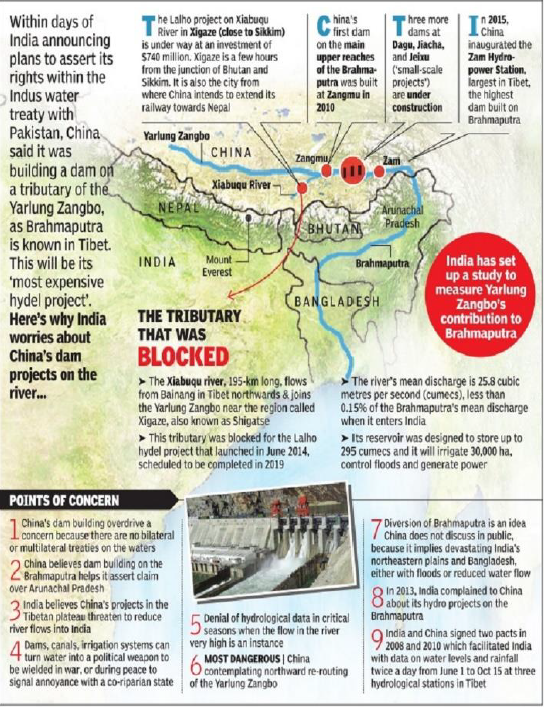
CHINESE DAM PROJECTS ON BRAHMAPUTRA
CONTEXT
- China is planning another dam on the Brahmaputra, a river that it is using to hydrate its drier regions.
- The new dam will come up at just 30 km from the India-China border along Arunchal Pradesh. China has already built several dams on the Brahmaputra as well as the Indus systems.
Concerns about Chinese project
- Control of Water– China could use the dam to control the flow of the river’s water into northeast India, either shutting off water supply to create a scarcity or suddenly releasing it to trigger flash floods.
- Opacity of Chinese Government – the Chinese have not been transparent about their dam-building activity. For instance, Beijing repeatedly denied plans to build a dam at Zangmu
- for several years, then went ahead with the construction of a hydropower project there.
- Storage of Water – China insists that the dams are and will continue to be run-of-river projects, wherein water will be returned to the river after use. India’s concerns are that these dams are large enough to be converted and used as storage dams, especially if the purpose is flood control and irrigation (as is the case with Zangmu Dam).
- Effect on Fertility of Soil – There is much apprehension that the Brahmaputra may lose the silt, which makes the plains in its basin fertile, because of sediment trapping in the dams.
- Earthquake prone area – all hydropower projects, particularly around the Great Bend, are located in a highly volatile tectonic zone. Their proximity to known geological fault lines, where Indian Plate collides with the Eurasian Plate, makes them extremely earthquake-prone.
- In 2008, the Three Gorges Dam on the Yangtze River gave way under the stress of an earthquake (7.9 on the Richter scale) in the eastern rim of Tibet, resulting in loss of many lives. This raises serious concerns about risks posed by big dams built in such seismically sensitive areas.
- Quality of water will be affected – In building its dams, China has also polluted its rivers. The quality of water that flows downstream into India needs to be taken into account. The disruption of natural flood cycles of the river could also adversely affect the rich geo-environmental and bio-physical settings in India’s northeast.
- No respect for International law – China had refused to sign and ratify the Helsinki Rules too. The gist of the Helsinki Rules is that each state within an international drainage basin has the right to a reasonable and equitable part of the beneficial use of the basin waters.
- Ecological impact – The Assam government had said that the Siang river (Brahmaputra’s name in Arunachal) was turning black with pollutants and samples of the Brahmaputra at Tezpur revealed that the water contained a large amount of mineral properties. Even experts have pointed out that dam construction could cause the river to lose its silt and lead to a reduction in agriculture productivity.
Way Forward
- Safeguarding India’s interests – India is not taking any chances this time and has already started planning a multipurpose 10,000 MW hydropower project in Arunachal Pradesh. This projects need to be implemented in fast track manner. There is need to change perception of India plans but effective execution done by china
- Decentralized water units on both sides – Building a decentralized network of check dams, rain-capturing lakes and using traditional means of water capture have shown effective results in restoring the ecological balance while supporting the populations of the regions in a sustainable manner.
- Cooperation with Bangladesh – India must coopt with Bangladesh, with whom India has good relations to tackle Chinese issue.
- Water sharing agreement – India and China do not have a water-sharing agreement and they should work upon it.
